Inhibiting microRNA-301b suppresses cell growth and targets RNF38 in cervical carcinoma
Funding information: Binzhou Central Hospital
Abstract
It has been reported microRNA-301b (miR-301b) was involved in the tumorigenesis of some cancers, but it has not been investigated in cervical carcinoma yet. In this study, miR-301b was found significantly upregulated in cervical carcinoma, and patients with high miR-301b expression had a shorter overall survival. When miR-301b was knocked down in cervical carcinoma cells, the cell growth could be significantly abolished. Our further studies showed miR-301b targeted RNF38, and inhibited its expression in cervical carcinoma cells. Moreover, RNF38 was found downregulated in cervical carcinoma, and miR-301b expression in cervical tissues was found negatively correlated with RNF38 expression. In addition, overexpression of RNF38 significantly inhibited cervical carcinoma cell growth, but overexpression of miR-301b suppressed RNF38-induced cell growth inhibition in cervical carcinoma. Collectively, this study suggested miR-301b could be a novel target for cervical carcinoma treatment.
1 INTRODUCTION
Cervical carcinoma is one of the malignant tumors that seriously affect women's life and health.1, 2 In China, the number of new cervical carcinoma patients is more than 120 000 every year, and about 20 000 to 30 000 patients die of cervical carcinoma.3 Cervical cancer is mainly caused by human papillomavirus, whose latent period can be up to 10 years.4 At present, if cervical cancer patients achieve early diagnosis and treatment, the cure rate can reach nearly 100%.5 However, the incidence of cervical carcinoma in young women is increasing year by year in recent years, and 80% of patients have developed invasive cancer when they are diagnosed.6
MicroRNA (miRNA) is a kind of small RNA discovered in recent years.7 MiRNAs display their functions in gene regulation by completely or incompletely complementary binding with the 3′UTR of target mRNAs.8, 9 More and more studies have shown that miRNAs act as oncogenes or tumor suppressors, which are involved in regulating cell growth, proliferation, and apoptosis of tumors, and also related to the occurrence and development of many tumors.10, 11
RNF38 is an ubiquitin ligase, which belongs to the RING E3-ligase protein family. It contains a coiled-coil motif and a RING-H2 motif at its carboxy-terminus, and RING motif is responsible for its function as an E3 ligase.12 RNF38 has been reported to be involved in the tumorigenesis of several cancers as a tumor promoter or suppresser. In hepatocellular carcinoma (HCC), RNF38 was elevated and promoted HCC progression by ubiquitinating and degrading AHNAK.12 However, RNF38 was also reported to be downregulated in colorectal cancer (CRC), and overexpressed RNF38 inhibited CRC cell growth by inducing LDB1 degradation through ubiquitin-proteasome pathway.13
In this study, microRNA-301b (miR-301b) was found elevated in cervical carcinoma, and knockdown of miR-301b significantly inhibited cervical carcinoma cell growth. Our further studies found RNF38 was a novel target of miR-301b. Moreover, RNF38 overexpression reduced cervical carcinoma cell growth, but overexpressed miR-301b significantly suppressed RNF38-induced cell growth inhibition.
2 MATERIALS AND METHODS
2.1 Cells, tissues, and culture
The normal cell line HcerEpic, and cervical carcinoma cell lines were purchased from ATCC, Manassas. All the cells were cultured in RPMI 1640 medium (Corning) with 1% penicillin/streptomycin and 10% FBS.
The paracancerous normal tissues and tumor tissues were collected from Binzhou Central Hospital. Clinicopathologic features of the patients were as shown in Table 1. Moreover, the clinical staging and clinicopathological classifications were determined according to the International Federation of Obstetrics and Gynecology (FIGO). The use of human tissues in this study was approved by the Institutional Review Board of Binzhou Central Hospital.
| Clinical parameters | Case (%) | |
|---|---|---|
| Age (y) | ≤50 | 7 (46.7) |
| >50 | 8 (53.3) | |
| Histology | Squamous cell cancer | 10 (66.7) |
| Adenocarcinoma | 5 (33.3) | |
| Tumor size (cm) | ≤3 | 6 (40.0) |
| >3 | 9 (60.0) | |
| Lymph node metastasis | Negative | 11 (73.3) |
| Positive | 4 (26.7) | |
| Depth of invasion | ≤2/3 | 6 (40.0) |
| >2/3 | 9 (60.0) | |
| FIGO stage | 0 | 5 (33.3) |
| I | 4 (26.7) | |
| IIa | 2 (13.3) | |
| IIb | 4 (26.7) | |
2.2 Quantitative real-time polymerase chain reaction
To evaluate miR-301b expression, quantitative real-time polymerase chain reaction (qRT-PCR) was used as described previously.14 The primers specific for miR-301b were synthesized from GeneChem (Shanghai, China). The MiRNeasy Mini Kit (QIAGEN, Germany) was used to extract total RNA, and the Quantscript RT Kit (QIAGEN, Hilden, Germany) was used to reverse transcribe the miRNA bulge-loop. The miR-301b expression was quantified using a TaqMan MicroRNA assay (Thermo Fisher Scientific) and normalized to U6 RNA levels.
To evaluate RNF38 expression, qRT-PCR was used with SYBR Green qPCR Master Mix (Novoprotein, China). The primers used were as follows: RNF38, forward 5′-TTCCTTCTTATCGGTTCA-3′ and reverse 5′-AACTCGTGGTTACAGGGT-3′; GAPDH, forward 5′-GCACCGTCAAGGCTGAGAAC-3′ and reverse 5′-TGGTGAAGACGCCAGTGGA-3′.
2.3 MiRNA, siRNAs, plasmid construction, and transfection
The miR-301b inhibitors, inhibitor-NC, miR-301b mimics, and mimic-NC were synthesized from GeneChem (Shanghai, China). The siRNAs against RNF38 were obtained from Ribobio, Guangzhou, China. The human RNF38 gene and its mutant (RING-H2 domain was deleted) were amplified by PCR, and cloned into pcDNA3.1 vector with a Myc tag. Cervical carcinoma cells were transfected with 100 nM miRNAs or siRNAs by Lipofectamine RNAiMAX (Invitrogen), and plasmids were transfected into cervical carcinoma cells by Lipofectamine2000 (Invitrogen) according to the manufacturer's instruction.
2.4 Cell growth and viability
Viable cells of cervical carcinoma cells were measured by CCK-8 according to the manufacturer's instructions (Bimake).
2.5 Luciferase assay
The fragments containing predicted miR-301b binding sites or the mutants were amplified by PCR and subcloned into pGL3 vector. Then, the plasmids along with inhibitor-NC or miR-301b inhibitors were transfected into HeLa cells for 48 hours, followed by luciferase assay using the Dual-Luciferase Reporter Assay System (Promega) according to the manufacturer's instruction.
2.6 Western blot
To detect the protein levels, western blot was carried out as described previously.15 The primary antibodies against cyclin D1, CDK4, p53, and GAPDH were purchased from CST, Danvers, Massachusetts. Anti-RNF38 and anti-myc tag antibodies were purchased from Santa Cruz Biotechnology, California.
2.7 Statistical analysis
To compare the differences between two groups, Student's t test was used, and all statistical tests were two-sided. P value less than .05 was considered statistically significant.
To analyze the overall survival of cervical carcinoma patients with low or high miR-301b expression, Kaplan-Meier plotter based on pan-cancer miRNA database was used.16 To analyze the expression of RNF38 in cervical squamous cell carcinoma and endocervical adenocarcinoma tumor tissues and normal tissues, GEPIA database matched TCGA normal and GTEx data was used online (http://gepia2.cancer-pku.cn/#analysis). Correlation analysis was performed by using GraphPad Prism 7 software. MicroRNA.org (http://www.microrna.org) was used to predict miR-301b targets.
3 RESULTS
3.1 MiR-301b is elevated in cervical carcinoma, and predicts a negative index for cervical carcinoma patients
To evaluate miR-301b expression in cervical carcinoma, paracancerous and tumor tissues of cervical carcinoma were collected. As shown in Figure 1A,B, miR-301b was elevated in cervical carcinoma tumor tissues compared with the paracancerous tissues. Then, four cervical carcinoma cell lines and one human normal cervical epithelial cell line were also prepared. As shown in Figure 1C, miR-301b was also found upregulated in cervical carcinoma cell lines compared with the normal cervical epithelial cell line. Additionally, the Kaplan-Meier plotter showed cervical carcinoma patients with high miR-301b expression had a shorter overall survival (Figure 1D). These data indicated miR-301b was a negative index for cervical carcinoma patients.
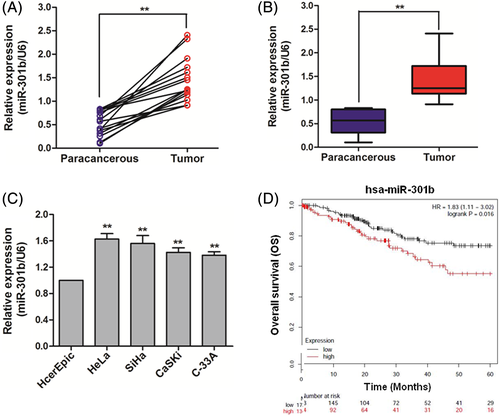
3.2 Silence of miR-301b inhibits cervical carcinoma cell growth
Subsequently, the miR-301b inhibitors were used to knock down miR-301b in cervical carcinoma cells, and the results showed miR-301b inhibitors could significantly reduce miR-301b expression in HeLa and CaSKi cells (Figure 2A). Moreover, silence of miR-301b markedly suppressed the cell growth in both of HeLa and CaSKi cells (Figure 2B,C). Additionally, knockdown of miR-301b markedly downregulated cyclin D1 and CDK4 expression, and upregulated p53 expression, which further indicated miR-301b inhibitors suppressed cell growth by regulating cell cycle progression (Figure 2D).
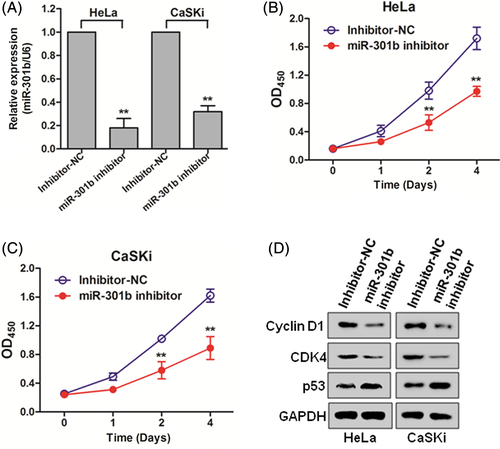
3.3 MiR-301b targets RNF38, and inhibits RNF38 expression in cervical carcinoma
Our further studies found, miR-301b was predicted to bind to the 3′UTR of RNF38 (Figure 3A). To elucidate it, luciferase assay was then carried out. As shown in Figure 3B, miR-301b mimics significantly decreased wild-type RNF38 3′UTR-driven luciferase activity, but miR-301b inhibitors significantly upregulated the luciferase activity. However, both of miR-301b mimics and inhibitors had no effect on the mutated RNF38 3′UTR-driven luciferase activity, which further indicated miR-301b targeted RNF38 (Figure 3B). To further confirm it, HeLa and CaSKi cells were treated with miR-301b inhibitors or mimics. As shown in Figure 3C,D, knockdown of miR-301b markedly upregulated RNF38 expression in cervical carcinoma cells, but overexpression of miR-301b significantly decreased RNF38 expression, which further suggested RNF38 was a novel target of miR-301b in cervical carcinoma cells.
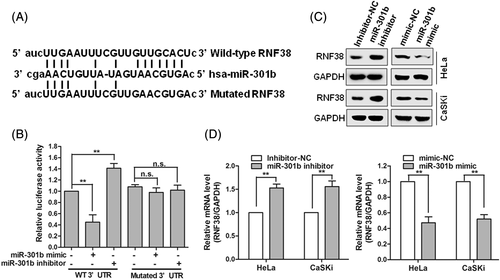
3.4 RNF38 is downregulated in cervical carcinoma, and negatively associated with miR-301b
It has been shown RNF38 was involved in the tumorigenesis of several cancers,12, 13 but its function in cervical carcinoma was not investigated. First, we investigated the public cancer database, and it showed RNF38 was significantly downregulated in cervical squamous cell carcinoma and endocervical adenocarcinoma tumor tissues compared with the normal tissues (Figure 4A). To further confirm it, paracancerous and tumor tissues of cervical carcinoma were collected. As shown in Figure 4B,C, RNF38 was significantly downregulated in the tumor tissues of cervical carcinoma compared with the paracancerous tissues. What is more, miR-301b expression in cervical carcinoma was negatively correlated with RNF38 expression (Figures 3 and 4D).
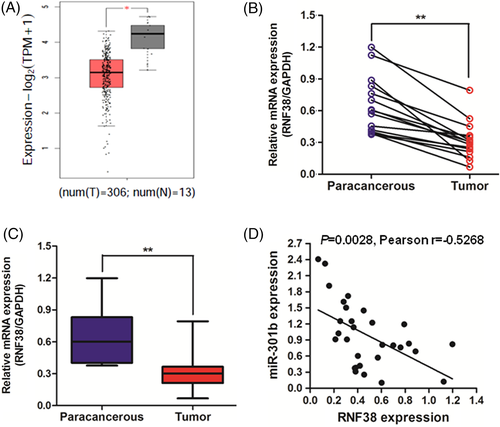
Moreover, overexpressed RNF38 significantly inhibited cell growth in both of HeLa and CaSKi cells, but not the mutant of RNF38, which indicated that RNF38 exerted its function through its E3 activity (Figure 5A,B). In contrast, knockdown of RNF38 could enhance cell viability (Figure 5C). However, overexpression of miR-301b significantly suppressed RNF38-induced cell growth inhibition in cervical carcinoma cells (Figure 5D,E). These results further suggested RNF38 was a target of miR-301b.
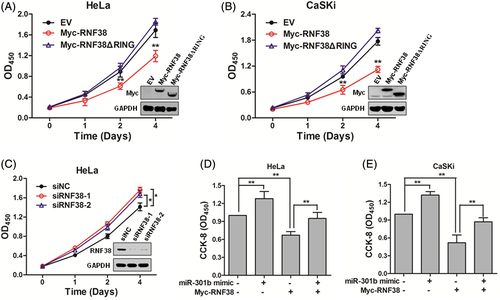
4 DISCUSSION
It has been reported miR-301b was involved in the tumorigenesis of several cancers. A recent paper reported miR-301b was upregulated in gastric cancer (GC), and knockdown of miR-301b inhibited GC cell proliferation, and induced cell cycle arrest and apoptosis.17 It also revealed ZBTB4 was a target of miR-301b, and miR-301b overexpression reduced its expression in GC cells.17 In pancreatic carcinoma, it was reported miR-301b overexpression suppressed TP63 expression and contributed to promote cell invasiveness and enhance gemcitabine resistance in pancreatic carcinoma cells.18 In addition, under hypoxia, miR-301a and miR-301b, two hypoxia responsive miRNAs were significantly upregulated in prostate cancer cells, and high expression of miR-301a and miR-301b resulted in elevated autophagy and increased radio resistance in LNCaP cells.19 Moreover, miR-301a was reported upregulated in cervical carcinoma, and overexpressed miR-301a could significantly promote HeLa cell proliferation by inhibiting PTEN expression.20 In this study, miR-301b was also found elevated in cervical carcinoma tumors and cell lines compared with the control, and inhibiting miR-301b significantly suppressed cervical carcinoma cell growth, which was similar to other reported functions of miR-301b in other tumors that all acted as an oncogene.
Our further studies showed miR-301b targeted RNF38, and inhibited its expression in cervical carcinoma. However, few studies have reported the roles of RNF38 in tumors,12, 13 and its function in cervical carcinoma has not been reported yet. In this study, RNF38 was found downregulated in cervical carcinoma, and overexpression of RNF38 significantly suppressed cervical carcinoma cell growth. However, the mechanism how RNF38 regulated cervical carcinoma cell growth has not been elucidated in this study, which would be further investigated in our future work. Additionally, as shown in this study, RNF38 was a novel target of miR-301b, and miR-301b was upregulated in cervical carcinoma, therefore, this article also proved the reason why RNF38 was downregulated in cervical carcinoma.
5 CONCLUSION
Collectively, our present study indicated targeting miR-301b/RNF38 axis could be a promising strategy for cervical carcinoma treatment.
ACKNOWLEDGMENT
We thank the support from Binzhou Central Hospital.
CONFLICT OF INTEREST
The authors declare no potential conflict of interest.




